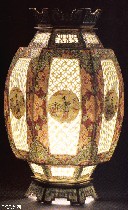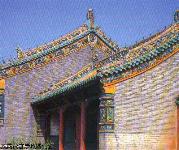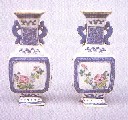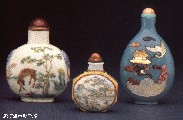 |
One beautiful example of early Chinese porcelain is
this small pot of a type called yu盂. Many of the Jin Dynasty 晉 pots have four eyes to be hung up. The cover of this brown glazed pot is decorated with two turtle-doves. |
 |
New shapes and decoration patterns shows this pot (type
bo 缽; by the way, modern Korean ricebowls with
the same shape are made from metal and are called jubal
周缽 "round bowls") from the
Eastern Jin Dynasty. Its yellow glazed surface is dotted
with brown points, that are added in a regular pattern on
belly and cover. The seize of the dots nonetheless is
very unregular and points out a begin of the intuitive
splotch decoration that is prevalent until the Tang
Dynasty. |
 |
Flower patterns like on this bowl from the Southern Dynasties 南朝 were still very rare during Han time 漢. The influence of lotus flowers in Buddhist art could have contributed to this new decoration pattern. A bowl sitting on a dish is also a new type. |
 |
Clear influence of Indian and Central Asian art shows
this pot from the Southern Dynasties period. Lotus
flowers and honeysuckle are composed in different layers,
one layer going up, the other showing to the bottom. |
 |
Glazed with brown color, this flat Northern Dynasties 北朝 bottle is decorated with musicians. Pictures of people are very important to reconstruct clothing, instruments, festivities, architecture and so on. |
 |
This 24 cm tall jar from the Northern Dynasties
already shows the three color glazing (sancai
三彩) that became very popular under Tang Dynasty. The glazing
is actually only made of two colors: green and brown, the
third color white being the ground material. Typical for
the period of division are the four eyes on the upper
part and the round shape of the vessel. |
 |
Another Northern Dynasties vessel is a prototype of the
worldwide known typical Chinese vase with the wide belly
and the long, straight neck. Unlike the overloaded Ming 明
and Qing 清 vases, this piece is decorated with a simple
green splotch. |
 |
The Song Dynasty 宋 porcelain is characterized by a very simple coloring and almost no decoration, like this 20 cm tall pure white covered bowl from the Five Dynasties period 五代. |
   |
But Song chinaware did not only use more simple colors than the elder porcelain. New shapes and patters arose. The left vase in a green coloring looks very modern in its appering with the round body and the slim neck.
A new technique of Song porcelain is the craquelée (kaipian 開片
or wenpian 紋片), making the glazing cracked all over as if it had been destroyed by temperature or water. The specimen on the right has a shape that reminds old bronze vessel types, but the two hallow tube-like handles on the side are a very new feature. Tallness about 20 cm. |
 |
A Song chinaware cup that shows the change of colors from the olive green-yellow-brown types of the Tang Dynasty (that were still en mode) to a color range of green-blue-violet. During the reign era Jingde 景德 (1004-1007), the Song emperor Zhenzong 宋真宗 (r. 998-1022) had established imperial manufacturies at a small town called Jingdezhen 景德鎮/modern Jiangxi. |
 |
Very typical for Chinese art are boxes that contain filial boxes or bowls. Most of these "box in the box" type contained cosmetics or medicine, and at the same time were a symbol of a lucky large number of children. |
 |
From the late Tang Dynasty on, when Buddhism declined, the object of Buddhist veneration shifted from the huge state protected Avalokiteshvara to the Bodhisattva Maitreya (chin. Milefo 彌勒佛), also called Buddha of the Future. The venerated Avalokiteshvara was usually depicted with feminine characters and is called Guanyin 觀音. The Guanyin was no object of state veneration but found his/her place in private household or small temples. The specimen of the left is a porcelain Guanyin from the Southern Song period. |
 |
The Yuan Dynasty brought new types of vessels. The type of cup to the left called "feeted cup" (zubei 足杯) was very popular from Yuan to the end of Qing Dynasty. It is 10 to 14 cm high and in most cases decorated in a very reserved manner. |
 |
If we think of chinaware or Chinese porcelain, we first talk of the blue-white patterned porcelain that is typical for the last 700 years of Chinese art history. It first came up during the Yuan Dynasty and often showed motifs like shown on the left, a white plate decorated with a blue dragon, clouds and flowers. |
  |
But also other types of vessels were decorated in blue-white. The slim vase with the broad shoulders on the left is a vessel type whose oldest specimen originate from the Song Dynasty. The progress in industrial manufacturing of porcelain allowed a refined style of these vases that often were covered by a small cup. 50 cm tall.
Typical for Yuan Dynasty vases is the low and thick bowl-like vase shown on the right side. The cover is shaped like the hat of a flower bud or a fruits when it starts to grow after the blossom-time is over. 30 cm tall. |
 |
Another example of feeted cups, zubei, from the Ming Dynasty, made of porcelain and different stones. |
 |
During Ming Dynasty, this town developed to an industrial town manufacturing porcelain. Ming artisans introduced red and yellow colors to the typical blue-white porcelain that is typical for chinaware. The box on the left is used to contain painting brushes, and it is decorates with dragons playing inmidst clouds and waves. |
 |
But the blue-white porcalain was very prevalent because it is cheaper to produce than mulit-colored vessels or objects. The plate to the left is only one example of the huge treasury of boxes, bowls and vases produced during the Ming and Qing Dynasty. Industrially manufactures porcelain was so cheap that it replaced metal and stone objects in a wide range, and the manufacturies produced such an amount of material that it could even be exported to Southeast Asia and Europe. |
  |
The vase on the left is a good example for the overloaded, some would say "kitschy" style of multi-colored chinaware that came up during late Ming Dynasty, ornated with red, orange, green, blue, and gold colors. On the contrary, there existed also very simple and barely decorated objects like the pair of vases on the right, used to flank an altar. They are only adorned with a dragon twirling around the slim neck. |
 |
The pot-bellied vase from the Yuan Dynasty were still seen during later centuries, but quite rare. The example to the left is 40 cm tall and is - surprisingly - not purely exerted with the typical blue colors, but the gold fish are painted in a realistic red-gold color. Fish are a symbol for fertility in Chinese thought. |
 |
Very famous among the tourists visiting China is the nine dragon wall in Beijing's Forbidden City (see Imperial Palace). These walls were erected just behind the entrance gate of a court to prevent bad ghost entering the house (ghosts were believed to be able to walk around corners, they can only walk straight ahead). The Ming Dynasty emperors who erected the "modern" Forbidden City in Beijing had this wall adorned with ceramic tiles showing nine dragons playing amidst the waves of a river. |
 |
These four vessels from the Qing Dynasty were used during the imperial offerings to the natural spirits. The right, red vase with a wide opening was used for the sun altar, the pale blue vase on the left for the moon altar. The dark blue vessel in the front, shaped like an old fu 簠 type bronze vessel from the Zhou Dynasty 周, was used for offering to Heaven, and the yellow vessel in the background, shaped like an old dou 豆 type bronze vessel, was used for the offering to the Earth. |
 |
Lanterns in China are often red colored and made of paper - we can see them in every China restaurant around the corner. The most expensive lanterns were made of paper-thin porcelain, like the example on the left. On each side of this octogonal lantern, we see a small painting, centered in a field of a grid-patterned light zone. The structural parts of the relief are thicker than the "hallow parts" and thereby give the impression of a grid. Similar effects are employed on the bottoms of cups and bowls. Holding the cup against direct light, a painting of a bird, a girl or anything else can be seen. |
 |
 Two examples shall show that Qing Dynasty bowls were not purely an industrial mass product of mean quality like we know them from the China food shop from the corner. While the bowl to the left shows us five different kinds of flowers on a coral red ground, the bowl to the right is partially covered with an enamel drawing of a pheasant among peony flowers. Two examples shall show that Qing Dynasty bowls were not purely an industrial mass product of mean quality like we know them from the China food shop from the corner. While the bowl to the left shows us five different kinds of flowers on a coral red ground, the bowl to the right is partially covered with an enamel drawing of a pheasant among peony flowers. |
  |
The advanced industrial technique allowed the creation of difficile shapes, decorations and styles. Typical for the Qing Dynasty chinaware is the gourd-shaped vase, made of porcelain "thinner than paper, whiter than jade", like the Chinese say. The right example is decorated with lefs, the vase on the left, only thickened on the top of the neck, is painted with a bird scene on an orange background. |
  |
A Song Dynasty vessel shape with broad shoulders still employed, Qing Dynasty artisans proved their skills for the example on the left to cover the body of the vase with a raised relief of leaves. The right vase, shaped like a gourd, divided its neck into three tubes, coming out of one single and unified body. |
 |
Glazed tiles are not only found in China but also on the roofs of European Middle Age buildings. But typical for Chinese tiles are the shapes of demons, dragons and monsters numbering five to seven that protect the buildings agains the devastating stroke of lightnings. The example to the left are two roof of the Qing summer palace in Shenyang 瀋陽/Liaoning (Mukden). |
 |
As Chinese thinking uses to pose two powers or elements into opposition (sun - moon, Heaven - Earth, male - female, dark - light), sets of pairs are also seen in Chinese art. The pair of vases on the left is a good example of industrial mass products to meet the needs of the common people, and at the same time, it is an example that not all vases or art objects are round, but that there are also quadrangular objects, symbolizing the earth. |
 |
The consume of cigars or cigarets has never been widespread in China until the 20th century. Instead, Chinese used to enjoy tobacco in the form of snuff. Accordingly, snuff-boxes were a very common item for daily use. The left and middle snuff-boxes are made from porcelain and are painted with a landscape, the right blue box is made from glass and shows a crane flying over a river and a temple. |